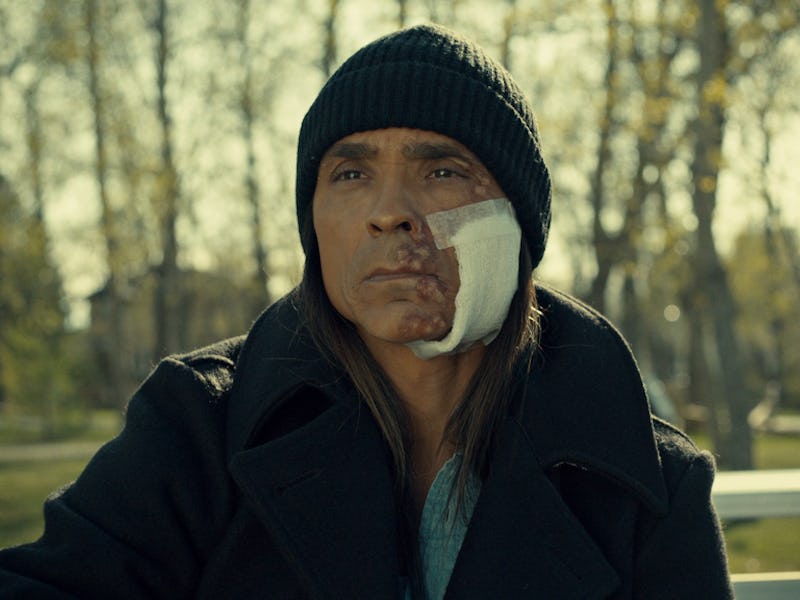Why Hank's Made-Up Language Wraps Up the 'Fargo' Season 2 Finale
How creator Noah Hawley's characters' cryptic ruminations and neat-and-clean endings wrap up the FX show's staggering second season.

One should be grateful Fargo’s second season didn’t end with a symbolic, ambiguous Coke ad. Fargo has always tread on a dangerous faultline, between mystery and pretentious suggestion and a more standard-issue, character-driven narrative. It beats its audience over the head with allusions and riddles, but retains the air of tradition.
Hawley’s show’s speculates heavily about the nature of the human condition. He chips away at it by emphasizing individual character’s struggles to “actualize” or understand, even in the midst of the show’s busiest and most brutal scenes. He undercuts melodrama with disarming humor, self-effacing music cues (this week, it’s Sabbath’s War Pigs), and giving side characters strange, winking turns in the spotlight.
In some ways, Fargo recalls films of classic foreign directors like Jean Renoir and Luchino Visconti, or in more recent years, [Andrey Zvyagintsev](https://en.wikipedia.org/wiki/Leviathan_(2014_film), in that it aims to subtly and sympathetically highlight all sides of the human psyche — beautiful and ugly — through a large ensemble cast. There is no Walter White or Don Draper or Tony Soprano — no central unknowable macho presence.
Therefore, Hawley manages to turn out a convincing “us” story, prying delicately at shared emotions and private struggles. The characters in Fargo fill out all sections of the enneagram, a rubric for personality type. He manages to clarify his ensemble even in extreme situations, instead of rendering them as mere pawns to further the action.
Fargo’s season finale gives resolution to nearly every major plotline in a relatively methodical fashion. Peggy is borne off to jail, Ed becomes a tragic anti-hero thanks to the one bullet he couldn’t dodge, and the Solversons are tenuously reunited in Luverne. As Hank puts it, it’s a blessing to just be there in the moment in their living room, though almost everything else about their future is uncertain. With elements like Hanzee meeting deux ex Shifty Guy on some bleachers to coordinate an identity change, Hawley is definitely not afraid to risk opening up the textbook, or resorting to devices some might call “easy outs.”
But the heart of the show is not these plot elements, but the beautifully styled dialogue lying closer to the surface. As we leave Fargo for another season, it’s details that stick with us: one-or-two liners, tiny reflections on what might have been.
Perhaps nothing is as striking in this episode as Hank’s final discussion of his invented “language.” After Hank saw combat, he became obsessed with the idea of all “conflict” in the world coming down to “miscommunication.” He grew obsessed with the idea that a new symbolic language — appealing to more basic, even childlike human instincts (“We know a heart means ‘love’”) — might prevent missed connections like these. Through this new lexicon, the human race might be conceivably be saved from the kind of darkness the characters in the show are put through, and will forever be reeling from.
Often, speech acts in Fargo are not received, or lie thick in the air — permanent riddles. No one’s language is as gestural as Mike Milligan’s, who speaks in the nonsense threats of “Jabberwocky,” who prefaces kills with mini-narratives apropos of nothing. He enters the death-filled Gerhardt house in last night’s episode with a cry of “People of Earth, I am here,” a line from a sci-fi film that doesn’t exist, to no one but a maid who can’t understand him. His threats are usually unspoken, buried in the subtext of a joke.
For others like the indefatigable Hanzee, language doesn’t easily capture his mental landscape. He fights to distill it on the bleachers in the finale, but finds no use for any of the words, or the concepts they weakly encapsulate: “Not apprehend, dead — no care ‘heavily guarded,’ no care ‘into the sea’…kill and be killed, head in a bag.” He then says, in his first language: “That’s the message.” It’s as unambiguous as Hanzee can be, outside of action.
The ever-expanding chaos in Fargo is closer to the specific reality for disenfranchised characters like Milligan and Hanzee — even the distraught Peggy. The latter clings desperately to axioms which reify a deep-seated infrastructure of warped hope. In Solversons’ cruiser, we realize she is desperately tried to escaping a world plagued by unreasonable double-standards and suffocating expectations.
But when the characters’ signals are not properly received — and when they deflect others’ — the disorder and even tragedy deepens. The moral compass Hank wants so desperately to find, and Solverson no longer knows how to believe in, decalibrates. At the end, in the Solversons’ home, the family struggles to find a point of reference again — a mantra before bed and the promise of a fishing trip.
If there are happy accidents, there are always unintended consequences — ye olde butterfly effect is the most pat trope in Fargo, but no less dramatically effective for it. As Milligan says — in this particular universe — acts of cruelty balance out acts of kindness, as if one cannot mean anything without the other.
So Fargo’s tsunami of cause and effect has broadened out, just to the brink of washing everything away. Now Hawley gracefully, almost effortlessly, has drawn everything back in. If most of the characters have found comfortable conclusions, the same central mysteries linger, and a strange, cold promise of the future. From the perspective of Betsy’s dream and Milligan’s new number-punching desk, it looks more efficient, but at its roots, it’s even more precariously balanced.